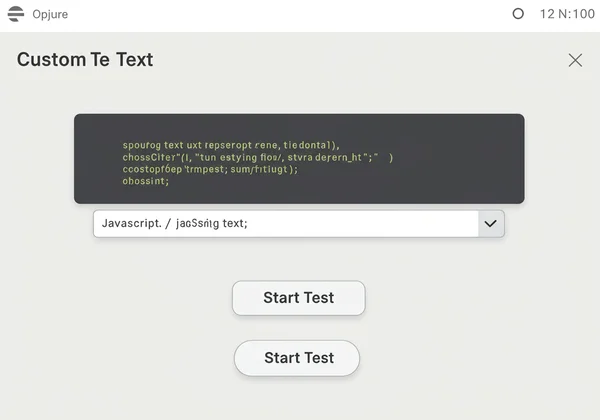WPM Test for Programmers: How to Boost Your Coding Typing Speed
As a programmer, your hands are your primary interface with the machine. You’ve likely taken a standard typing test and scored well, but then you return to your IDE and feel a disconnect. The fluid rhythm of typing prose shatters against the jagged landscape of parentheses, curly braces, and arrow functions. This frustration is a shared experience in the developer community. Effective typing for programmers isn't just about words; it's about syntax, symbols, and structure. How can I test my typing speed and accuracy in a way that actually reflects your daily work?
The truth is, standard WPM (Words Per Minute) tests fail to measure what truly matters for coders. Improving your coding-specific typing speed directly translates to higher productivity, less mental friction, and more time spent solving complex problems instead of fighting with your keyboard. This guide will break down why typing code is a unique skill and provide a clear, actionable path to improvement using a tool designed for real-world practice. Ready to get started? You can take a free wpm test to establish your baseline right now.
Why Your coding typing speed Is Different
Before you can improve, you must understand the unique challenges. A high WPM score on a generic test might not correlate to faster coding. Your coding typing speed is a specialized metric influenced by factors that prose-based tests completely ignore. It's not just about typing faster; it's about typing smarter and more accurately within the rigid constraints of a programming language.
The Challenge of Special Characters and Syntax
Think about your last coding session. How much of it was typing actual English words versus navigating special characters? Programmers constantly type (), {}, [], =>, &&, ||, !, and ;. These symbols are often located in awkward positions on the keyboard, requiring finger contortions that break your typing flow.

Each programming language has its own unique cadence and set of common symbols. Typing Python, with its reliance on indentation and colons, feels vastly different from writing JavaScript, which is dense with braces and semicolons. A standard typing test doesn't prepare your fingers for these syntactic demands, leading to frequent pauses and errors when you’re in the zone. Mastering the placement of these characters is the first step toward true coding fluency.
Muscle Memory: Prose vs. Programming Languages
When you type a sentence, your fingers move in familiar patterns, honed over years of writing emails and documents. This is muscle memory at work. Common letter combinations like "the," "and," and "ing" become automatic. However, this muscle memory offers little help when you're typing const express = require('express'); or for (let i = 0; i < array.length; i++).
Coding introduces entirely new and repetitive patterns. Your fingers need to learn the dance of declaring a function, writing a loop, or defining an object. This requires building a completely different set of muscle memories. Without targeted practice on actual code, you are essentially forcing your brain and fingers to re-learn on the fly with every line you write, which is a major drain on cognitive resources.
Why Accuracy Trumps Raw Speed in Code
In creative writing, a small typo is easily overlooked. In programming, a single misplaced comma or a forgotten semicolon can break an entire application, leading to minutes or even hours of frustrating debugging. This makes typing accuracy paramount. Sacrificing accuracy for a few extra WPM is a terrible trade-off for any developer.
A fast but sloppy coder creates more work for themselves and their team. The goal is to type code that is both fast and correct on the first attempt. This is why effective practice must focus on precision. By training your fingers to hit the right keys every time, you not only increase your effective speed but also significantly reduce the time spent fixing syntax errors. Improving your accuracy builds confidence and allows you to maintain a state of flow for longer periods.
How to practice typing code with Our Tool
Generic typing tutors won't cut it. To improve your coding speed, you need to practice typing code that mirrors what you write every day. This is where a targeted approach makes all the difference. The most effective method is to use a tool that allows you to train on real-world examples, and our platform is perfectly equipped for this task.
Using Our Custom Text Feature for Real-World Code
The single most powerful tool for a programmer on our platform is the custom text feature. It allows you to transform any piece of code into a personalized typing test. This moves you from practicing irrelevant sentences to honing the exact skills you need for your job. The process is simple, free, and requires no registration.
Here’s how to do it:
-
Go to your current project or find a code example online (e.g., from GitHub or a tutorial).
-
Copy a function, a class, or any code snippet you find challenging.
-
Visit the custom text feature on the homepage.
-
Paste your code snippet into the text box.
-
Start the test!

By doing this, you are no longer practicing in the abstract. You are building muscle memory for the specific syntax, keywords, and variable names relevant to your work. It's the most direct and efficient way to see tangible improvements in your daily coding.
Drills for Common Snippets: Loops, Functions, and Conditionals
To build a strong foundation, focus your practice on the most common programming constructs. Create dedicated practice sessions using code snippets of loops, functions, and conditional statements. These patterns appear in virtually every programming language and are often where typing slows down.
For example, grab a few of these and run them through our custom text tool:
- JavaScript For Loop:
for (let i = 0; i < data.length; i++) { console.log(data[i]); } - Python Function:
def calculate_sum(a, b): return a + b - React Component:
const MyComponent = ({ title }) => { return <h1>{title}</h1>; };
Run a keyboarding test with each snippet multiple times. Pay attention to where you slow down. Is it the parentheses? The curly braces? The equals sign? Isolate your weaknesses and drill them until they become second nature.
Measuring Your Programmer WPM Accurately
After you complete a custom text test on our platform, you'll get a detailed report including your WPM, CPM, and accuracy. This is your true Programmer WPM. Don't be discouraged if this score is lower than your traditional WPM; that's completely normal and highlights the difference between the two skills.

Use this metric as your benchmark. Track your Programmer WPM over time as you practice different types of code. Notice how your speed with JavaScript snippets might differ from your speed with Python or SQL queries. This data-driven approach allows you to see real progress and identify which areas need more work. The goal isn't just a high score—it's consistent, accurate typing that makes you a more efficient developer.
Start Your Programmer-Focused Typing Practice Today
Improving your typing speed as a programmer is not a vanity metric; it's a direct investment in your productivity and professional development. Typing code is a specialized skill that requires dedicated, relevant practice. By moving beyond generic typing tests and focusing on the syntax, symbols, and patterns of your chosen programming languages, you can eliminate a significant bottleneck in your workflow.
Remember these key points on your path to faster coding: recognize that coding is different, prioritize accuracy over raw speed, and use targeted practice to build relevant muscle memory. The tools to start this journey are at your fingertips.
Stop guessing your coding speed. Grab a code snippet from your current project, head over to our platform, and use our custom text feature to get your true programmer WPM score right now! See where you stand and begin the path to becoming a faster, more fluid, and more efficient coder today.
Frequently Asked Questions About Typing for Programmers
What is a good WPM for a programmer?
This is a common question, but there's no single magic number. While the average prose typist is around 40 WPM, a "good" programmer WPM is more about accuracy and comfort with syntax. Many experienced developers type at a deliberate 50-70 WPM when coding, prioritizing accuracy to avoid bugs. Instead of chasing a high score, focus on achieving a smooth, error-free pace. You can easily get your programmer WPM using our custom text feature to set a personal benchmark.
How can I improve my typing speed for coding specifically?
The most effective method is deliberate practice with real code. Use the custom text feature on a typing test platform to practice with snippets from your own projects or open-source repositories. Focus on common structures like loops, functions, and object declarations. Additionally, mastering touch typing for symbols (like {}[]()/;) and utilizing keyboard shortcuts in your IDE will provide significant gains. The key is consistency and relevance in your practice.
Does fast typing actually make you a better programmer?
Fast typing alone doesn't make you a better programmer, but it does make you a more efficient one. The primary benefit is reducing the friction between your thoughts and the code on the screen. When typing is effortless, you can stay in a state of "flow" for longer, focusing on high-level problem-solving instead of searching for keys. Slow, inaccurate typing acts as a constant interruption, breaking your concentration. Therefore, improving your coding typing speed is a powerful way to unlock your full potential.